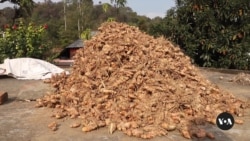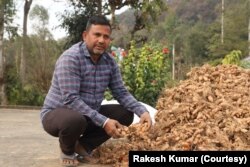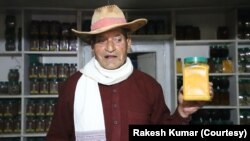Pappu Kumar has harvested his first crop of turmeric from the farm that he abandoned many years ago when he migrated to work in the Indian capital. He hopes the spice, which is widely used in Indian cooking, will turn his farm in Hardial village in North India into a lucrative venture.
“Traditional crops that we used to plant like corn and wheat often got diseases. Stray animals or even wild animals like deer used to enter the fields and eat the crops. That does not happen with turmeric,” said Kumar.
Disheartened with the challenges of tilling their land and the meager income it yielded, he was among thousands who migrated from rural areas to work in towns and cities. Over the years, vast tracts of farmland in Himachal Pradesh state became fallow.
But when the COVID-19 pandemic dried up livelihoods in cities and triggered a wave of reverse migration into villages, Kumar was among hundreds who returned.
Now many of the returnees are exploring alternative farming as they try to rebuild their lives in the countryside.
Kumar was inspired to grow turmeric by a man who had transformed his own farms by planting the spice. “I grew turmeric because this is a hardy crop that is not affected by diseases, it itself has antibiotic properties,” said former army colonel P.C. Rana who came back to his village after he retired.
Growing turmeric needs less labor and water. Moreover, crops are not attacked by animals such as monkeys, which have become a huge menace for farmers in India. Displaced by shrinking forests, they scour farms for food and destroy crops worth millions of dollars every year.
After studying the cultivation of turmeric in Indian states where it was being grown, Rana planted a variety with a high percentage of the compound curcumin which gives the spice its yellow color and health benefits. The “turmeric man of Himachal Pradesh” as he is now known, grows it organically, which protects the soil and yields higher profits.
"I follow the principles of natural farming — no tractors should till the fields, no chemicals and pesticides should be used, and weeds and crop stubble should be recycled to fertilize the land,” he said.
Rana’s success has prompted scores of farmers to cultivate turmeric. Others are growing herbs such as aloe vera and lemongrass, for which demand is increasing and which are also not attacked by animals.
In the hilly state that is crisscrossed by cold water streams, other options to traditional agriculture are also getting attention. Those whose homes lie close to streams have built ponds to breed trout, a fish for which demand is increasing hugely in affluent cities and among tens of thousands of tourists who visit the state.
Since starting his trout farm about three years ago, Arjun Kumar, a former building contractor, has built a successful venture selling trout and setting up a hatchery to produce fertilized fish eggs.
“In the last two years I have sold fish seed for $6,000 a year and trout worth about $70 a day,” Kumar says.
The hope is that such alternative farming ventures will boost rural economies and create new livelihoods. Nearly half of India’s population relies on agriculture for a living, but over the years, farm incomes have stagnated.
India’s agriculture is dominated by wheat and rice cultivation – a trend the government had encouraged in the 1960s and 1970s due to severe shortages of food grains in the country.
But with India now producing surplus rice and wheat, experts say farmers, who complain of dwindling incomes, need to explore other options.
“Moving to growing alternate crops or other farm ventures is a step in the right direction,” according to Devendra Sharma, an agriculture expert. “I always advise farmers to diversify at least part of their land away from staples such as wheat. This is a trend which even local governments are now encouraging.”
The hope is that new farm-based ventures will also boost employment in a country struggling to create jobs for its 1.4 billion people. With two-thirds of the population under 35, joblessness is highest among the young.
“Trout fish farming is a good venture for unemployed youth. After the COVID-19 pandemic, so many have come back to their home and are searching for such opportunities,” according to Madhu Sharma, head of the fisheries department at the CSK Agricultural University in Palampur.
There are pitfalls ahead — such as global warming which is altering weather patterns.
“Water temperature is changing. That impacts the breeding of fish. The water temperature rose by one or two degrees in May and June. That puts stress on the fish,” pointed out Sharma.
But despite challenges, many are vowing to persevere in their effort to resettle in the countryside, where they say life is better than in the crowded towns and mega cities where they worked for decades.
Pappu Kumar has made a modest beginning by cultivating turmeric, but he hopes to expand this year.
“Rather than search for work outside, I want to turn my farm into a profitable business. I still have a lot to learn about turmeric cultivation, but I will plant it across more land,” said the optimistic farmer as he prepared to take the harvested crop to sell in the local market.













